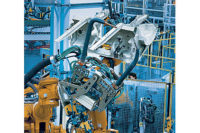Bosch Rexroth’s introduction of adaptive control in 2012 advanced the quality and efficiency of robotic resistance welding. Using cutting-edge hardware and software, adaptive control monitors various process parameters to perfect each weld. The system samples weld parameters on a millisecond basis, compares them in real-time against a master resistance curve, and automatically adjusts the process to ensure consistent, quality welds.
However, recent trends in the automotive industry, such as lightweighting and electrification, presented challenges for this technology. As a result, Bosch Rexroth has developed more sophisticated adaptive resistance control systems that incorporate advanced software and dual-processor architecture.
One of the most significant new challenges for adaptive control of resistance welding comes from the increased use of high-strength steel and aluminum in vehicle bodies and parts.
Aluminum alloys are also difficult to weld. Aluminum is soft, highly sensitive and insulated by a tough oxide layer. While in its molten state, aluminum is susceptible to impurities, which can lead to porous, weak welds. Since aluminum has high thermal conductivity and a low melting point, it has a smaller window of workability than other metals, which can easily lead to burn-through.
The core of adaptive control is the capability to adjust the quality of the weld within a millisecond time frame. Key parameters, such as current, voltage, force, time, resistance and phase angle, can be manipulated to overcome the anomalies inherent in welding these new materials.
In addition, Bosch Rexroth has introduced a force feedback system that can measure the expansion of aluminum due to heat and can adapt the process accordingly. This is done by calculating data from the expansion of the welding gun tips and then regulating the weld through adaptive control of the weld tip pressure and the current being applied.
The company’s new PRC7000 adaptive resistance welding control platform offers this capability. It also expands the number of heat blocks available so that welding system programmers and technicians can fully customize the current waveform for each weld. Previously, automated resistance welding platforms typically supported three heat blocks: the pre-weld, the weld itself and the post-weld. While effective, having only three heat blocks did not give welding operations the ability to create more sophisticated welding sequences that could respond better to minute variations in the parts being welded, such as specialized coatings, poor fits between two parts being welded, or changes in the amount of carbon or other trace alloys in newer high-strength, lightweight steel alloys.
The PRC7000 can store up to 10,000 welding programs that can be easily selected and built via a drag-and-drop graphical interface. Engineers can create sophisticated welding sequences with 100 or more heat blocks. Through user-friendly programming tools, each heat block can be configured as needed to handle the specific weld criteria.
For example, a particular weld for a higher-strength steel might need a pre-weld at 30,000 amps to heat the steel for 30 milliseconds, then a long transition to a higher force with a lower current for 500 to 600 milliseconds to contain the material. Each part or each type of material can now have more dynamically designed welds so that manufacturers have greater freedom to control and improve welding results. Engineers can add and store as many heat blocks as needed to create the perfect weld nugget and, ultimately, the perfect weld every time.
Weld Spot Analytics software automatically compiles weld spot data into easy-to-read formats and dashboards, enabling an expanded level of real-time analysis and process improvement for welding operations. Photo courtesy Bosch Rexroth Corp.
Software can also help assemblers deal with these new materials. Available as an option for the PRC7000, Weld Spot Analytics (WSA) software gives engineers a greater level of real-time analysis and process improvement for welding operations. Until recently it was up to car manufacturers to download welding data and incorporate it into their own analytical tools. The WSA package automatically compiles the weld spot data into easy-to-read formats and dashboards. Operations personnel can configure dashboards to monitor their day-to-day responsibilities and also for more long-term process analysis. The software can also send automatic text messages, such as preventive maintenance updates and quality issue alerts, to welding operators who can take steps to correct issues and maximize uptime.
WSA is designed to help engineers make faster, more accurate decisions that increase weld quality and decrease rework. That same data can then be correlated to other factors, such as part fit-up or secondary circuit degradation to help production management more rapidly identify the root cause of electrode wear.
A wide range of reports can be created to help troubleshoot problems. For example, if spot quality appears to be randomly affected by expulsions, it can be difficult to obtain a holistic view of all the expulsions for a specific time frame or part being welded. WSA can supply an expulsion report table that shows the percentage of spots with expulsions to help with root cause analysis.





